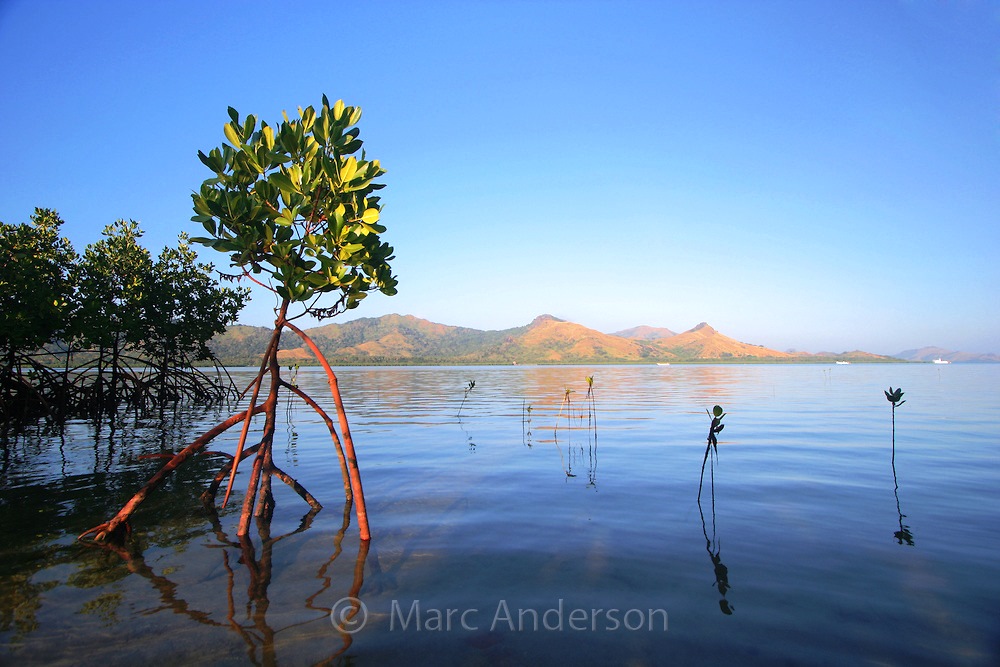International Day for the Conservation of the Mangrove Ecosystem – IUCN Oceania Regional Director’s Statement
Every year on 26 July, we celebrate the International Day for the Conservation of the Mangrove Ecosystem. The day was designated by UNESCO in 2015 to raise awareness on the integral role of mangrove ecosystems as unique, special and vulnerable ecosystems, and to promote solutions for their conservation, sustainable management and utility.

Photo: Mangroves in Fiji by Marc Anderson
The inclusion of mangroves in Biosphere Reserves, World Heritage sites, and UNESCO Global Geoparks contributes to improving the knowledge, management and conservation of mangrove ecosystems throughout the world. One such Biosphere Reserve in the Pacific is the Ngaremeduu Biosphere Reserve in Palau, which incorporates the largest estuary in Micronesia, with spans of mangroves comprising 44% of Palau’s mangrove forest with 18 different mangrove species.
In Fiji, 90% of our mangroves are dispersed around the two main islands of Viti Levu and Vanua Levu. There exist nine species of mangroves in Fiji - Rhizophora stylosa and Rhizophora x selala, which grow on the seaward edge; then Bruguiera gymnorrhiza, Excoecaria agallocha, Lumnitzera littorea and Xylocarpus granatum, which grow further inland; whilst Rhizophora samoensis is scattered throughout.
These mangroves provide valuable ecosystem services for human wellbeing including provisioning, regulation, habitat and cultural services. Mangroves provide timber, firewood, charcoal and blue carbon storage; regulate flooding, buffer storms, protect coastlines with erosion control, and mitigate salt water intrusion; provide nursery habitats, breeding and spawning grounds for commercial fish species, crustaceans and other biodiversity; and cultural services such as recreation and for aesthetic appreciation for greenery.
These inherent characteristics create an undersupply of mangroves by the market system, or ‘market failure’, as the potential for incentives to sustainably manage mangrove ecosystem services are limited. The lack of awareness on the value of mangrove ecosystem services has generally led to their omission, and under- appreciation as natural capital, in both private and public decision-making in relation to their utility, conservation and restoration. We need information on the economic value of mangrove ecosystem services that can be compared directly against the economic value of alternative public investments. Therefore, as a carbon- rich ecosystem, the mangrove ecosystem warrants Payment for Ecosystem Services (PES) incentives.
The mangrove ecosystem is constantly threatened. Recent studies of mangroves in the Rewa and Ba River deltas (Avtar, et al., 2021) have shown a 12% decrease in mangroves in the Rewa delta, and a growth of 9% in mangroves in the Ba River delta, over the last 20 years. This compares to a global loss of 36% of mangroves in the same period. In Fiji, mangroves are threatened by anthropogenic needs such as for firewood and food (mud crabs, mud lobsters, fish, etc.); natural disasters like cyclones; land reclamation for other agricultural crops like rice and sugar cane; and development such as the building of roads, townships, etc. (Avtar, et al., 2021).
In our efforts to combat this loss and fast-track better management practices, IUCN became a founding member of the Global Mangrove Alliance (GMA). IUCN is the focal point for the Community of Ocean Action (COA) on Mangroves with the RAMSAR secretariat. IUCN has also facilitated several mangrove restoration projects such as the Mangrove Ecosystems for Climate Change Adaptation & Livelihoods (MESCAL) Project in Fiji, Vanuatu, Samoa, Solomon Islands and Tonga from 2009- 2013; the Mangrove Rehabilitation for Sustainably-Managed Healthy Forests (MARSH) Project in PNG in 2013- 2015; and the Red List of Ecosystem (RLE) Risk Assessment of mangroves on Tongatapu in Tonga 2019- 2021. Additionally, we have several current projects that could fund mangrove- related projects: the Kiwa Intiative, BIOPAMA and the GCF CMERP projects.
Most recently, in the last fortnight, a handful of IUCN Oceania staff, along with our conservation partners, underwent training with the Global Mangrove Alliance for the development of the Mangrove Restoration Tracker Tool (MRTT), which is an exciting standardised tool that will be used globally to track mangrove restoration progress.
As we celebrate the International Day for the Conservation of the Mangrove Ecosystem, let us take action to conserve and restore our mangrove ecosystems, and advocate for appreciation of its value in terms of ecosystem services, and to promote its long- term sustainable use.
Mason Smith, Regional Director of IUCN Oceania
